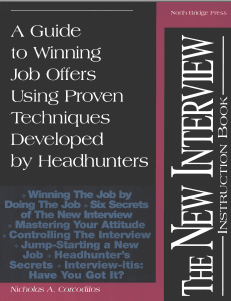In the June 16, 2015 Ask The Headhunter Newsletter, an old friend re-surfaces… for a little while!
The New Interview Instruction Book is BACK!
20 years ago, Ask The Headhunter was born from a discussion forum I started on Prodigy (does anyone remember Prodigy?) and a book titled The New Interview Instruction Book. The book was for sale only by mail order direct from me and from the Motley Fool, the personal finance site that hosted the ATH discussion forum — before I created the ATH website, newsletter and blog.
 It was in The New Interview Instruction Book that I introduced the key concepts and methods that are still the foundation of Ask The Headhunter — methods for landing the right job by demonstrating that you can do the job profitably.
It was in The New Interview Instruction Book that I introduced the key concepts and methods that are still the foundation of Ask The Headhunter — methods for landing the right job by demonstrating that you can do the job profitably.
The book was taken out of circulation when Penguin Putnam bought the rights and issued a revised edition named Ask The Headhunter: Reinventing The Interview to Win The Job (1997). That book became a bestseller, and finally went out of print a few years ago.
Until now, neither edition has been available (except used). Now a limited number of copies of the original book are available until the supply runs out.
If you don’t have The NIIB or its successor, you can order your own original copy of the classic NIIB for $29.95 + shipping. (This is a physical, 157-page book, not a PDF. Check out the Table of Contents. All orders will ship Priority U.S. Mail. Note: This book is similar to the successor 1997 edition issued by Penguin Putnam as Ask The Headhunter: Reinventing the interview to win the job.)
Of course, a 20-year-old book has some anachronisms in it! But the concepts and the how-to are exactly what we discuss in this newsletter all the time — except there’s more how-to and much more detail! The methods in this book are just as valid and powerful today as they were in 1995! Please note that because quantity is limited, there are no returns or refunds on this book.
In this edition of the newsletter, I’d like to reprint a key section of The NIIB: The Six Secrets of The New Interview (pp. 21-24). I hope you enjoy it!
6 Secrets of The New Interview
The Six Secrets of the New Interview are not really secrets, because every good headhunter recognizes these facts, and uses them every day.
- Insiders have the best shot at the job.
- The real matchmaking is done before the interview.
- The interview is an invitation to do the job.
- The employer wants to hire you, and he will help you win the interview.
- The boss wants one thing from you: he wants you to solve a problem.
- You will win the job by doing it.
Let’s look closely at what the Six Secrets of the New Interview really mean.
1. Insiders have the best shot at the job.
Other things being equal, the boss will hire someone he [or she!] knows before he hires someone he does not know. Why? Because he has more information about people he already knows, like other company employees, than he has about you. And, the information he has is more reliable.
Part of a headhunter’s job is to build his candidate’s reputation within a company before the candidate goes on the interview. You can accomplish this for yourself, if you know how. In the sections that follow, we will discuss how you can make an employer perceive you as a valued employee rather than an outsider.
2. The real matchmaking is done before the interview.
The work of matching a worker with a job takes place before the interview, not during the interview. You have heard it said that in a courtroom a lawyer never asks a witness a question to which the lawyer does not already know the answer. Similarly, a headhunter never sends a candidate to an interview unless the headhunter already knows the candidate can do the job. You must ensure the same for yourself.
3. The interview is an invitation to do the job.
Most people treat an interview like an interrogation. One person asks questions, the other gives answers. This is wrong. Headhunters go out of their way to structure interviews to avoid this very unfavorable scenario.
An interview is a meeting between you and the employer — you are equals. The traditional notion of the all-powerful interviewer and the deferential candidate is hogwash. Unfortunately, this notion is promoted each time someone says that a candidate was interviewed by an employer.
The root of the word “interview” means between. “Interview” does not imply that one person is doing something to another. It refers to an exchange of information between two or more people. Specifically, it does not imply that the employer has power over you, the candidate. The only power either of you has is power you have each granted to the other. If you grant an employer the power to intimidate you and interrogate you under a hot light, then that’s your decision. Unfortunately, that’s what a lot of candidates allow to happen. Interviewers (and personnel jockeys) take advantage of it.
There is one power you and the employer share. If you can capitalize on it, you will turn the interview into a decisive problem-solving experience that will make the employer view you and treat you like a member of his own team. This power lies in your choice to work together, with the employer, to get the job done. This means avoiding interrogations. It means doing the job in the interview. We will talk more about how you can put this power to work, and thereby avoid getting interviewed in the traditional sense.
4. The employer wants to hire you, and he will help you win the interview.
This might seem absurd to some. It’s not. It is precisely why the employer is meeting with you. Every headhunter knows that. The headhunter counts on the employer being ready to hire the candidate. So should you. If the employer hires you, he wins, too. He can stop interviewing, and he can start earning the profits that having you on the job will yield.
Give the employer what a good headhunter gives him: proof that you can do the work. He wants you to be the right candidate. Half your battle is won. No other single fact about interviewing ever made me more relaxed, comfortable and powerful in an interview when I was looking for a new job.
5. The boss wants one thing from you: He wants you to solve a problem.
Every employer who interviews you has a problem: a job that needs doing. Most candidates don’t solve the boss’s problem because they don’t know what the problem is, and because they’re too busy “doing the interview”. That’s what keeps headhunters in business — job candidates who can’t identify and solve the boss’s problem.
A headhunter makes sure his candidate knows exactly what problem he has to solve to win an offer. If one of your predecessors had proved they could solve the employer’s problem, the employer would not be talking to you.
Ask yourself The Four Questions before you meet the boss. If you can answer them all “yes”, go in and do the job. How do you do the job before you are hired? Solve one or more of the manager’s problems during the interview. See what happens.
6. You will win the job by doing it.
You will not win the job by talking about it. Managers end interviews with, “I’ll get back to you” when they can’t decide whether to hire you. That’s because they’re not sure you can do the job. What more compelling way is there to convince a manager to hire you than to do the job the way he wants it done right there in front of him? If you waste your meeting answering questions rather than doing the job, you will lose the job to another candidate who was well prepared to do the job.
Good headhunters know these secrets and apply them all the time. They treat all interviews as practical meetings with a purpose, and the purpose is to show that a job candidate can do a job so that he or she will be hired. The headhunter devotes all his energy to achieving this purpose.
I  have shared these ideas over the years with job candidates I’ve sent to meet my clients. It is important for candidates to recognize how important they are to the employer. I want them to see interviews for what they are: opportunities for skilled people to demonstrate to an employer the best way a job can be done.
have shared these ideas over the years with job candidates I’ve sent to meet my clients. It is important for candidates to recognize how important they are to the employer. I want them to see interviews for what they are: opportunities for skilled people to demonstrate to an employer the best way a job can be done.
These ideas will change your job hunt in some very important ways if you put them to work. You will be freed from the banality of the traditional interview. You will form a relaxed attitude about interviewing and develop the confidence and power a talented worker should have. You will blossom from a job candidate into the solution to a manager’s problem.
I know I’m making you wait, but I can’t teach you how to use methods that work until you first understand why the rules drilled into your head by the employment industry are a waste of your time. In the next section we will look more closely at why traditional interviews don’t work. We’ll take a practical look at why companies use the traditional interview process, how they misuse it, and how this puts job hunters at a disadvantage. Understanding the problem will help you make the best use of the concepts presented in this book.
[The New Interview Flowchart shows the key steps to a job offer, from p. 154.]Reprinted from The New Interview Instruction Book. This classic is available only while the limited supply lasts!
These are age-old ideas for landing a job. When I wrote a book about them long ago, I didn’t expect I’d be discussing these ideas with you 20 years later! Do they still hold up? I think they do — mainly because thousands of you have proven it to me! Are there secrets of your own you’d like to add?
: :

